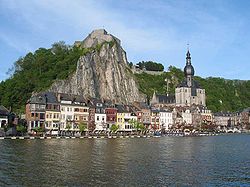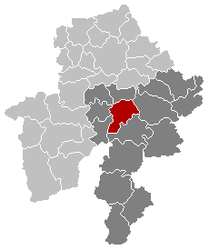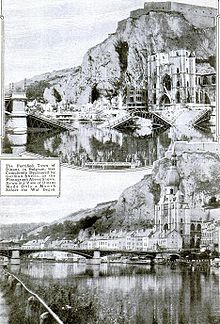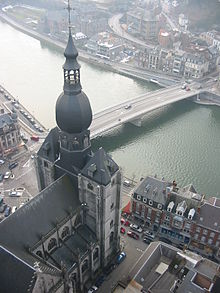- Dinant
-
Dinant The citadel, the collegiate church and the Meuse. 
Flag
Coat of armsLocation in Belgium Coordinates: 50°16′N 04°55′E / 50.267°N 4.917°E Country Belgium Region Wallonia Community French Community Province Namur Arrondissement Dinant Government – Mayor Richard Fournaux (LDB) – Governing party/ies LDB Area – Total 99.80 km2 (38.5 sq mi) Population (1 January 2010)[1] – Total 13,317 – Density 133.4/km2 (345.6/sq mi) Demographics – Foreigners 3.52% (7 January 2005) Postal codes 5500, 5501, 5502, 5503, 5504 Area codes 082 Website www.dinant.be Dinant (French pronunciation: [di.nɑ̃]) is a Walloon city and municipality located on the River Meuse in the Belgian province of Namur, Belgium. The Dinant municipality includes the old communes of Anseremme, Bouvignes-sur-Meuse, Dréhance, Falmagne, Falmignoul, Foy-Notre-Dame, Furfooz, Lisogne, Sorinnes, and Thynes.
Contents
History
Origins to the 10th century
The Dinant area was already populated in Neolithic, Celtic, and Roman times. The first mention of Dinant as a settlement dates from the 7th century, a time at which Saint Perpete, bishop of Tongeren (with see now at Maastricht), took Dinant as his residence and founded the church of Saint Vincent. In 870, Charles the Bald gave part of Dinant to be administered by the Count of Namur, the other part by the bishop of Tongeren, then Liège.
In the 11th century, the emperor Henry IV granted several rights over Dinant to the Prince-Bishop of Liège, including market and justice rights. From that time on, the city became one of the 23 ‘‘bonnes villes’’ (or principal cities) of the Bishopric of Liège. The first stone bridge on the Meuse and major repair to the castle, which had been built earlier, also date from the end of the 11th century. Throughout this period, and until the end of the 18th century, Dinant shared its history with its overlord Liège, sometimes rising in revolt against it, sometimes partaking in its victories and defeats, mostly against the neighbouring County of Namur.
Late Middle Ages
Its strategic location on the Meuse exposed Dinant to battle and pillage, not always by avowed enemies: in 1466, Philip the Good, Duke of Burgundy, uncle of Louis de Bourbon, Prince-Bishop of Liège, and Philip’s son Charles the Bold punished an uprising in Dinant by casting 800 burghers into the Meuse and setting fire to the city. The city's economic rival was Bouvignes, downriver on the opposite shore of the Meuse.
Late Medieval Dinant and Bouvignes specialised in metalwork, producing finely cast and finished objects in a silvery brass alloy, called dinanderie and supplying aquamaniles, candlesticks, patens and other altar furniture throughout the Meuse valley (giving these objects their cautious designation "Mosan"), the Rhineland and beyond.
Henri Pirenne gained his doctorate in 1883 with a thesis on medieval Dinant.
The Old Regime and World War I
In the 16th- and 17th-century wars between France and Spain, Dinant suffered destruction, famine and epidemics, despite its neutrality. In 1675, the French army under Marshal François de Créquy occupied the city. Dinant was briefly taken by the Austrians at the end of the 18th century. The whole Bishopric of Liège was ceded to France in 1795. The dinanderies fell out of fashion and the economy of the city now rested on leather tanning and the manufacture of playing cards. The famous couques de Dinant also appeared at that time.
The city suffered devastation again at the beginning of the First World War. On 23 August, 674 inhabitants were summarily executed by Saxon troops of the German Army — the biggest massacre committed by the Germans in 1914. Within a month, some five thousand Belgian and French civilians were killed by the Germans at numerous similar occasions.[2] Among the wounded was Lieut. Charles de Gaulle.
Sights
- The city's landmark is the Collegiate Church of Notre-Dame. It was rebuilt in Gothic style on its old foundations after falling rocks from the adjacent cliff partially destroyed the former Romanesque style church in 1227. Several stages for a pair of towers on the west end were completed before the project was abandoned in favour of the present central tower with a famous onion dome and facetted multi-staged lantern.
- Above the church rises the vertical flank of the rocher surmounted by the fortified Citadel that was first built in the 11th century to control the Meuse valley. The Prince-Bishops of Liège rebuilt and enlarged it in 1530; the French destroyed it in 1703. Its present aspect, with the rock-hewn stairs (408 steps), is due to rebuilding in 1821, during the United Kingdom of the Netherlands phase of Dinant's chequered history. A cable car is available during the high season to take visitors from the Collegiate Church of Notre-Dame to the top of the Citadel.
- Apart from the main block is the Rocher Bayard that was said to have been split by giant hoof of Bayard, the giant horse carrying the four sons of Aymon on their legendary flight from Charlemagne through the Ardennes, told in Les Quatre Fils Aymon, a famous 12th-century chanson de geste.
- The house of Adolphe Sax, inventor of the saxophone located in the street of the same name
Culture
- The Flamiche is the local version of quiche
- The couque is Europe's hardest biscuit (American "cookie"), with a honey-sweetened flavour that is impressed with a carved wooden mould before baking.
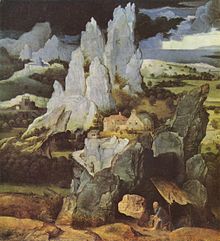 Saint Jerome, by Joachim Patenier (circa 1520). The rocks of Dinant were an inspiration for Patenier, one of the first landscape painters.
Saint Jerome, by Joachim Patenier (circa 1520). The rocks of Dinant were an inspiration for Patenier, one of the first landscape painters.
Born in Dinant
- David of Dinant, philosopher (birth in Dinant is uncertain, 12th century)
- Joachim Patenier, 1485–1524, painter
- Antoine Joseph Wiertz, painter (19th century)
- Adolphe Sax, inventor of the saxophone (19th century)
- Georges Pire, Dominican monk and Nobel Peace Prize recipient (20th century)
- André-Eugène Pirson (Dinant, 21 March 1817-Brussels, 28 December 1881), governor of the National Bank of Belgium (NBB) from 1877 until 1881.
- André Buzin, artist and stamp designer (20th century)
Twin cities
 France: Dinan
France: Dinan Portugal: Caldas da Rainha
Portugal: Caldas da Rainha United Kingdom: Hoddesdon
United Kingdom: Hoddesdon Greece: Chios
Greece: Chios Philippines: Cagayan de Oro
Philippines: Cagayan de Oro
See also
References
- ^ Population per municipality on 1 January 2010 (XLS; 221 KB)
- ^ John Horne and Alan Kramer. The German Atrocities of 1914: A History of Denial, New Haven and London, Yale University Press, 2001. ISBN 0-300-08975-9. [A large summary http://209.85.135.104/search?q=cache:7Z-4E_hgEkkJ:www.h-et.org/reviews/showpdf.cgi%3Fpath%3D48071096633975+Horne+Kramer+%2B+German+Atrocities&hl=fr&ct=clnk&cd=5&client=safari ]
External links
- Official web site in French, Dutch, and English
- Dinant groups on Flickr
- Citadel of Dinant: Official web site
- A Rough Guide to Dinant
- Map of Dinant with localisation of Adolphe Sax House
Municipalities in the Province of Namur Dinant 
Namur Andenne · Assesse · Éghezée · Fernelmont · Floreffe · Fosses-la-Ville · Gembloux · Gesves · Jemeppe-sur-Sambre · La Bruyère · Mettet · Namur · Ohey · Profondeville · Sambreville · SombreffePhilippeville Categories:- Populated places in Belgium
- Municipalities of Namur
- Wallonia's Major Heritage
Wikimedia Foundation. 2010.

